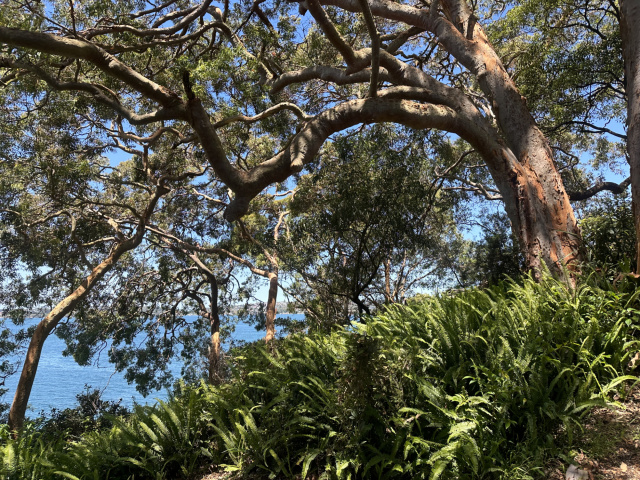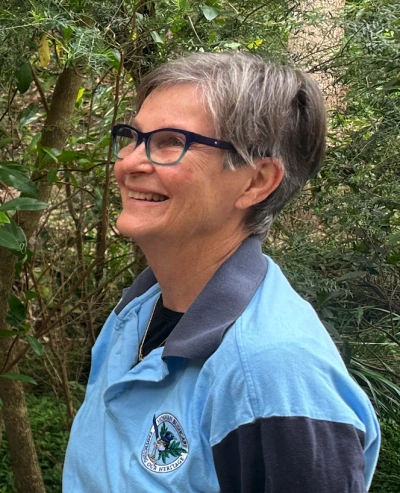Importance of the bush in Mosman
I’m a bush regenerator, and I’m on the committee of the Mosman Parks and Bushland Association. The bush provides corridors for the animals and the bird life to move from place to place. Otherwise they become isolated pockets and that's not good for their health. If they're isolated, over time they'll die out.
So there are fights for the bushland. There are fights for bushland within Mosman, and it's not just for the Mosman locals. These are places that everyone are entitled to.
Sometimes people say, about developments that will damage the bush, that “yes, you don't want it, because it's your backyard”.
And it is our backyard, but it's also everyone's backyard. It's there for everyone to enjoy.
COVID really brought out how much we do need this sort of environment to survive, and for our sanity. I love the peace of the bush, the sound of the birds, just seeing the natural environment.
Conserving the bush a long-term project - middle head and Mosman
There are boxes and boxes of papers dating back to the 1960s on the history of the Mosman Parks & Bushland associations’ efforts to conserve the bush in Mosman. The very first publication that Eileen and Joan Bradley had done, which was really one of the instigators of the group, was a book on the behaviour and plumage of blue wrens. This is just a lovely little history of observations made in Ashton Park on her walks there.
There was a period in the late 70s and 80s, where a whole lot of the eucalypts were dying along the foreshore around Mosman. The studies have been recorded of when they're trying to find why the trees were disappearing and dying. It's quite fascinating.
And then there are records of the history of bush regeneration techniques, and the tools you need, and the weeds, all how they've evolved, along with more recent battles for the foreshore. And then we've had the middle head oval, with some Mosman locals wanting plastic turf, and that argument being won so that now we have natural turf there.

Bush crucial for people and Nature
Since the bushland has been most recently regenerating across the road, I've been seeing more Native birds back again, so it's hopeful, but not easy. Then there's the importance of our need for the forest, of walking through a park or walking through native bushland. We call it forest bathing.
I think it's keeping our sanity. It keeps my sanity, put it that way. And I'm sure it does for a lot of other people.

Margaret Woodforth
Importance of the bush in Mosman
I’m a bush regenerator, and I’m on the committee of the Mosman Parks and Bushland Association. The bush provides corridors for the animals and the bird life to move from place to place. Otherwise they become isolated pockets and that's not good for their health. If they're isolated, over time they'll die out.
So there are fights for the bushland. There are fights for bushland within Mosman, and it's not just for the Mosman locals. These are places that everyone are entitled to.
Sometimes people say, about developments that will damage the bush, that “yes, you don't want it, because it's your backyard”.
And it is our backyard, but it's also everyone's backyard. It's there for everyone to enjoy.
COVID really brought out how much we do need this sort of environment to survive, and for our sanity. I love the peace of the bush, the sound of the birds, just seeing the natural environment.
Conserving the bush a long-term project - middle head and Mosman
There are boxes and boxes of papers dating back to the 1960s on the history of the Mosman Parks & Bushland associations’ efforts to conserve the bush in Mosman. The very first publication that Eileen and Joan Bradley had done, which was really one of the instigators of the group, was a book on the behaviour and plumage of blue wrens. This is just a lovely little history of observations made in Ashton Park on her walks there.
There was a period in the late 70s and 80s, where a whole lot of the eucalypts were dying along the foreshore around Mosman. The studies have been recorded of when they're trying to find why the trees were disappearing and dying. It's quite fascinating.
And then there are records of the history of bush regeneration techniques, and the tools you need, and the weeds, all how they've evolved, along with more recent battles for the foreshore. And then we've had the middle head oval, with some Mosman locals wanting plastic turf, and that argument being won so that now we have natural turf there.

Bush crucial for people and Nature
Since the bushland has been most recently regenerating across the road, I've been seeing more Native birds back again, so it's hopeful, but not easy. Then there's the importance of our need for the forest, of walking through a park or walking through native bushland. We call it forest bathing.
I think it's keeping our sanity. It keeps my sanity, put it that way. And I'm sure it does for a lot of other people.
You might like...

Restoring urchin barrens in Sydney Harbour

From Bulldozers to Bush Regeneration

The joy of bush regeneration

Growing up wild and healthy
Newsletter
Sign up to keep in touch with articles, updates, events or news from Kuno, your platform for nature
